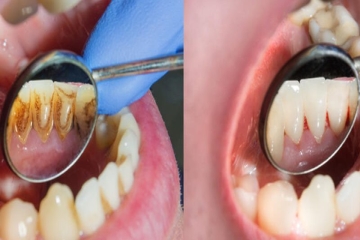Laminate veneer coating ( leaf porcelain veneers ) is one of the most preferred restoration applications in aesthetic dental surgery. Laminate means thin layer as a dictionary meaning, veneer also means coating. When we translate it into Turkish, it means thin coating, and it is also used as a laminated tooth in our country. Veneers are usually applied for extreme discoloration disorders that cannot be changed by teeth whitening, correction of the appearance of a split tooth (diestema), teeth whose surface is worn and deformed, teeth that are broken and damaged to a certain extent. The construction is; after a certain amount of thinning of the tooth surfaces, the measurement continues by taking and producing teeth of the desired shape, color. The laminate coating is attached to the surface of the tooth with a resin-based adhesive and an aesthetic image is obtained. This coating method is usually used to restore the upper teeth in front. The suitability of the tooth for use on the lower jaw or other tooth surfaces is determined as a result of a doctor's check.
Laminate veneer coating and its application
In Which Cases Laminate Veneer (Laminated Tooth) Is Recommended
With laminated dental treatment, the problem due to many factors is corrected. Some of these are as follows.
Tooth discoloration(stained teeth): Teeth whitening treatment is recommended primarily for patients who are dissatisfied with tooth stains or tooth color. But even as a result of some patients' teeth whitening process, it does not change. The reasons for this vary depending on hereditary or multidrug use. Because it is applied to the front surfaces of laminate veneer teeth, the tooth color has a white appearance when viewed from the outside.
Damaged and damaged teeth: The surface of the tooth or a certain part of it may have been damaged after the damage it received or the trauma it suffered. This can be in the form of abrasion of the tooth surface, indented protrusion, fracture of the tooth tips. Even if this also occurs on 1 or more teeth, a laminated tooth can be coated according to your other tooth colors with the treatment applied.
Anterior Dental Cavities(Diastema): All large and small spaces between the front teeth are restored quickly with laminate veneer Decking. This is the fastest solution for removing December teeth that attract attention when you talk or smile.
Treatment of Short Teeth: In patients who are dissatisfied with the tooth length for clinical or hereditary reasons, the tooth length is extended restoratively and a beautiful appearance is achieved.
Malformation and Enamel Hypoplasia: Malformation is that the tooth is in a different shape and shape than it should be, experiencing a developmental disorder at the stage of development. Hypoplasia, on the other hand, means that the tooth enamel erodes and does not fully develop again. In both cases, image restoration is provided aesthetically with the laminated veneer application.
Labial(Front) Surface Restoration: Restoration may be required due to unhealthy conditions or caries on the front surfaces of the teeth that patients have. This is one of the appropriate cases for the use of a laminated tooth.
Partial Rotation and Malposition: Teeth may settle into the mouth as rotated or confused under development or different influences. In addition, teeth are also corrected in malposition, which is called closure or settlement disorder. With orthodontic treatment, such problems are permanently corrected, but laminated veneer is applied as a short-term remedy or for non-very large distortions with a duration of the treatment process of 1 or 2 years.
Laminate Veneer Coating and Its Advantages
There are many features that stand out in the laminate veneer coating process, unlike other dental aesthetic operations. The first of these is its natural appearance. Natural tooth enamel has a semi-transparent structure, which causes it to allow light to pass through. The ability to reflect light is one of the most remarkable features of the tooth. In laminated coatings, just like in natural teeth, it reflects light by filtering and allows it to pass through. With the light hitting the actual internal structure of the tooth and returning, the coating has a natural appearance. One of the most important features of Veneer is that it is incredibly resistant to stains. The patient does not have any color change concerns during the process of using the coating. Because there are no bumps on the outer surfaces of the products used in this treatment method, and the colors do not have the ability to penetrate deeply, as in tooth enamel. Normal teeth have small gaps that are not visible to the eye. Buddha causes the tooth to color easily. These small gaps are not found on the surface of the laminate veneer coating. Another feature of laminate veneer coating is that it is multi-purpose. Laminated teeth are easily applied to store many images such as distortions in our teeth, teeth turning in another direction, color changes, stains.
What is the Difference Between Porcelain Veneer and Composite Decanter?
Porcelain laminate veneer coating is both stronger and more durable than composite. Porcelain laminate veneers are more preferred for long-term use. Because the porcelain type surface is flat and smooth, it is highly resistant to staining. Buddha makes it look much more natural and clean than composite coating.Jul. Composite laminate veneer is much cheaper than porcelain, but this does not mean that they are good. The unstable structure of composites causes them to change more frequently and incur costs. Composite veneers are preferred for very small shaping operations. Laminated teeth, on the other hand, can be conveniently used in any area because they are glued to the front surface of the teeth.
How is the Leaf Porcelain Process Performed?
-First of all, the patient visits the clinic doctor with the condition he complains about and the patient's wishes are listened to with a detailed oral examination. In this examination, the patient's wishes are listened to in detail and the patient is told all the details with the cost to be formed.
-In the first or second session, your doctor makes your teeth, where the porcelain sheets will be placed, ready for the procedure, that is, he makes the cutting process. The front surfaces of your teeth are Decayed with this process in such a way that they vary between 0.3 mm -0.5 mm. Local anesthesia may need to be applied during the etching process. Buddha prevents you from feeling pain.
-The doctor takes the measurement of your mouth and teeth using a spoon created from a special paste. This means that the tooth marks will appear on the paste and the details of the laminate veneer coating to be made are ready for the laboratory.
-Leaf coverings suitable for your teeth are prepared with the measurement sent to the laboratory.
-In order to avoid experiencing sensitivity because your teeth are eroded, your doctor may attach temporary porcelain sheets to you or cover the front surfaces with temporary filler.
-At your next appointment, your doctor will replace your laminated teeth that have been prepared for you. Before the replacement procedure, your doctor will help you to see your posture.
–Your teeth are cleaned to fine detail once again before the laminate veneer coating is placed. The front surfaces are made suitable for the adhesive to adhere to the coating very well.
-As the last procedure, the veneers placed in their places are strengthened with the help of a special light that you may have seen at the dentists before. Buddha allows laminated teeth to be permanently attached to your teeth now.
How Much Are the Prices of Leaf Porcelain Veneer?
The cost of this procedure is related to many factors such as the product spent, the doctor's experience, the clinic performed, the patient's oral condition, the difficulty of the procedure. Pricing is prohibited by the Turkish Dental Association. If you want to get information about laminated tooth prices before the preliminary examination, you can contact us easily.







